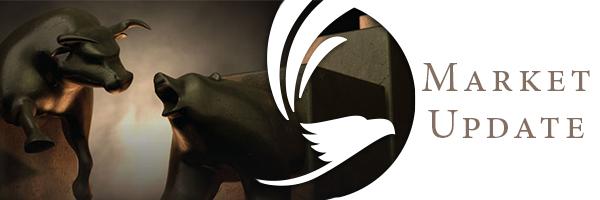We’re talking about climate risk (+ baby jaguar)
Hi Eagle Wealth Community,
Need a distraction from your day? Scroll down to the bottom of this email. There’s a baby jaguar.
But first, let’s talk about climate change.
The wildfires, hurricanes, and floods we’ve seen in 2020 (on top of an already-awful global pandemic) make this an important conversation to have. Think climate change isn't an issue? Well, the market consensus is moving in the other direction.
Insurers, government entities, and large investors are treating climate change as a major systemic risk to financial markets.1 Why? Because many companies and sectors are at risk from the costly heatwaves, wildfires, droughts, floods, and hurricanes that come with a warming planet.2
So, what does climate change mean for investors?
Investors worry that climate risk could cause the prospects of certain companies to drop dramatically and ricochet throughout the financial system (much like what happened during the 2008 financial crisis).
But, unlike a global issue such as the coronavirus, the effects will play out differently around the country and the world. Flood- or wildfire-prone areas could experience disruptions in business or find it difficult to insure homes and structures against damage. Agriculture could be damaged by droughts and heat stress. Already-warm areas could become too hot for comfortable habitation.
But, if the world goes all-in on sustainability too suddenly, there’s also a danger that the “transition risk” caused by new regulations or widespread shifts in energy use could also hurt markets or certain sectors of the economy.3
Well, what’s the good news?
There's hope. Many of the worst effects of climate change will play out over years and decades, not weeks and months. There’s time for people, businesses, and governments to adapt. And humans are infinitely adaptable. And there’s hope that the worst-case scenarios about a hotter world might not come to pass.4
We believe that optimism and pessimism can (and often should) co-exist. We’re pessimistic about the climate path we’re on. We’re optimistic that we will make the changes needed to get on the right path and steer away from the worst effects of climate change.
As your financial professionals, we’re staying on top of the growing body of risk models and research to help you chart a path through an increasingly uncertain world. You’ve heard us say it time and time again, when there’s volatility in the markets we have to remember what we can control…ourselves. You already have a financial plan, tailored to your goals, now it’s time to stay the course.
Ok, enough about climate change. Here are the distractions we promised.
Here’s a jaguar kitten learning how to swim.
Listen, we know distractions can only last so long. So, if you have worries (whether they be climate change, social issues, political or personal) and are wondering how they may impact your financial plan, let’s talk.
Warm Regards,
Your Eagle Wealth Team
Give a man a fish and you feed him for a day, teach him how to fish and you feed him for a lifetime – and they also have a whole bunch of fun while they’re at it!
Last week our favorite financial dynamic duo, Mat & Ian, headed to the Lower Deschutes River for their annual fishing trip. Mat’s catch of the day included a whopping 18lb wild steelhead (the average fish in the Lower Deschutes is 8-10lbs)!
Mat with an 18lb Wild Steelhead Ian & Mat with a 12lb Chinook Salmon
How about you? Are you making the best of this fall season? Send us your favorite fall photos, we’d love to see them!
The Week on Wall Street
Stocks advanced last week, propelled by hopes that legislators may reach an agreement for a new fiscal stimulus package and optimism generated by a few corporate deal announcements and initial public offerings.
The Dow Jones Industrial Average rose 1.87%, while the Standard & Poor’s 500 increased 1.52%. The Nasdaq Composite index gained 1.48% for the week. The MSCI EAFE index, which tracks developed overseas stock markets, advanced 1.56%.[i],[ii],[iii]
The Quarter in Brief
The summer brought an economic rebound and a continuation of the stock market rally that began in spring. In late September, the Federal Reserve Bank of Atlanta's GDPNow tracker estimated real Gross Domestic Product (GDP) growth of 32.0% for the third quarter. All three of the major Wall Street benchmarks advanced in Q3; the S&P 500 added nearly 8%, ending the quarter up about 4% for the year. Even so, U.S. equities slumped in September as traders worried that the stock market might be getting ahead of the economy.[iv],[v]
In Washington, the Federal Reserve altered its monetary policy stance and forecast low-interest rates for the near future. Hopes for another economic stimulus dimmed in Congress. On Main Street, the coronavirus pandemic remained top of mind, but improvements in hiring, consumer confidence, and retail sales were evident.
Entering the fourth quarter, analysts wondered how adroitly the financial markets might manage some unknowns: a potential uptick in COVID-19 cases in the fall, the pace of vaccine development, the outcome of the presidential election, and undetermined prospects for additional economic support of businesses and households.
Looking Back, Looking Forward
Stocks powered through July and August, entering historic territory in mid-summer. In particular, August saw a powerful rally. The Nasdaq Composite climbed 9.59% in August, and the Dow Jones Industrial Average gained 7.57%, finishing with its best August since 1984. Advancing 7.01% to cap a 5-month winning streak, the S&P 500 had its best August since 1986. September got off to a good start, with a new record close for the S&P: 3,580.84.[i],[ii]
Then, reservations about the rally surfaced. Traders began to question the sustainability of the summer economic recovery, and whether a fall uptick in coronavirus infections might hurt business and consumer spending. The S&P ended September at 3,363.00, retreating 3.92% for the month. The Dow lost 2.28% in September to fall to 27,781.70, and the Nasdaq gave up 5.16%, declining to 11,167.51.[iii],[iv
The 10-year Treasury yield spent all of Q3 between 0.52% and 0.74%, reaching the top of that range in late August.[v]
Wall Street enters the fourth quarter with a bit of uncertainty. The November election results may produce any number of reactions. There are only educated guesses as to when coronavirus vaccines may appear, and how effective they may be. The first reading on 3rd-quarter Gross Domestic Product growth is on October 27, roughly one week before election day.
Federal Reserve officials expect low-interest rates and very little inflation through 2022. Sustained low-interest rates could drive more borrowing and business investment, and improve the outlook for the housing market.
1https://www.nytimes.com/2020/09/08/climate/climate-change-financial-markets.html https://www.nytimes.com/2020/07/21/climate/investors-climate-threat-regulators.html
2https://www.spglobal.com/en/research-insights/featured/the-big-picture-on-climate-risk
[i] The Wall Street Journal, October 2, 2020
[ii] The Wall Street Journal, October 2, 2020
[iii] The Wall Street Journal, October 2, 2020
[iv] Federal Reserve Bank of Atlanta, September 25, 2020
[v] CNN Business, September 30, 2020




